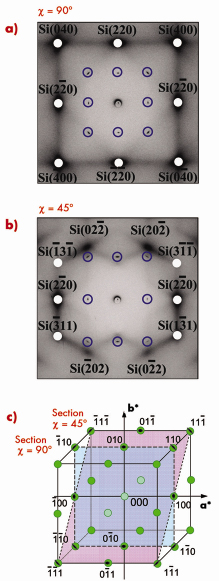- Home
- Users & Science
- Scientific Documentation
- ESRF Highlights
- ESRF Highlights 2007
- Materials Science
- High-throughput screening of combinatorial materials libraries by high-energy diffraction
High-throughput screening of combinatorial materials libraries by high-energy diffraction
Inorganic materials can acquire functional properties such as superconductivity in complex combinations of the components. Discovering useful compositions is difficult and time consuming. Fortunately, recent technological advances help speed up this gold-mining process. Several research groups have begun fabricating complex materials libraries in the form of continuous composition-spread thin films [1]. In order to reach the ultimate goal of producing structure-property maps, the materials science community demands fast high-throughput structural characterisation of the composition spreads [2].
Here we describe scanning transmission high-energy X-ray diffraction (HEXRD) and apply it to a high-throughput structural analysis of the ternary CeO2–Al2O3–HfO2 composition-spread thin-film materials library, deposited on a single-crystal Si(100) substrate. These oxide insulators exhibit high dielectric constant (high-k) and are presently being investigated as prospective gate compounds for MOSFET transistors. A schematic of the spread is shown in the inset of Figure 21. The sample consists of three interpenetrating and intermixed stripes of elemental oxides rotated with respect to each other by 120°.
The high-energy X-ray diffraction experiments were performed at beamline ID15B. We used transmission geometry instead of conventional reflection geometry. Transmission is achieved by employing a high-energy X-ray beam, E = 89 keV, which penetrates thick samples without substantial absorption and reduction of intensity.
High-energy X-rays produce Ewald spheres with large and almost flat sections in the forward direction in reciprocal space. This allows one to set up diffraction conditions similar to high-resolution transmission electron microscopy, where all the information on the in-plane structure of the film can be retrieved with a single illumination. Unambiguous identification of epitaxial phases then becomes possible. This is accomplished by a 3-dimensional reconstruction of reciprocal space around the origin: the thin-film sample is tilted in the incident beam at fixed X,Y-position, and additional diffraction images are recorded at every angle.
For combinatorial exploration, the ternary composition spread was scanned in the X and Y directions with the X-ray beam at normal incidence. By analysing the 2-dimensional Laue diffraction patterns the ternary crystal phase diagram was reconstructed as a colour ‘bubble plot’. In this plot the size of the solid bubble corresponds to the amount of a particular crystal phase calculated from the integrated diffraction intensity. The reconstruction of the ternary crystal phase diagram for the CeO2–Al2O3–HfO2 spread is shown in Figure 21. Part of the spread around the Al2O3 corner contained amorphous compounds hard to discern with X-rays. Corresponding pixels in the phase diagram are shown as empty spaces. In the crystalline part of the spread, we found eleven polycrystalline and four previously unknown epitaxial phases.
 |
|
Fig. 21: Bubble plot reconstruction of the crystal phase diagram for the CeO2–Al2O3–HfO2 composition-spread thin film on Si(001) substrate. Polycrystalline phases: (1) monoclinic HfO2; (2) cubic Hf0.97Al0.03O2; (3) tetragonal Al0.1Hf0.9O1.95; (4) rhombohedral Hf3Al2O9; (5) Hf7Al2CeO19 fluorite; (6) Hf6Ce3AlO19 distorted fluorite; (7) Hf4CeO5.5 cubic fluorite; (8) cubic CeO2; (9) tetragonal Ce0.85Hf0.1Al0.05O1.975; (10) cubic Ce3HfO8; (11) Ce8Al2O19. Epitaxial phases: (12) Ce1.12Al0.88O3 apatite; (13) hexagonal Ce1.06Al0.94O3; (14) tetragonal Ce0.95Al0.95Hf0.1O3.05; (15) cubic CeAlO3 perovskite. |
By way of example, Figure 22 shows the diffraction pattern for the compound CeAlO3 at incident angles of 0° and 45°. For this particular phase, other tilt angles contained no diffraction signals from the epitaxial thin film. The figure also illustrates the reconstruction of reciprocal space indicating an epitaxial phase with a cubic perovskite crystal structure and lattice parameter a = 3.87 Å.
 |
|
Fig. 22: Diffraction patterns from the epitaxial perovskite phase (a) for normal incidence, and (b) for an incident angle of 45°. The additional signals originate from unsubtracted thermal diffuse X-ray scattering around Si Bragg peaks. (c) Reconstruction of reciprocal space for the epitaxial perovskite. |
In summary, we have demonstrated that focused synchrotron radiation with high-energy X-rays is the most adequate probe for producing structural maps for multicomponent materials libraries. It provides fast characterisation in a single measurement, high compositional/spatial resolution, and high throughput. In addition, it has unique advantages that substantially facilitate positive identification of epitaxial phases. Complete phase maps can be constructed after initial screening at a fixed X-ray beam incident angle. After the identification of epitaxial areas on the composition-spread thin film, a small number of additional measurements with the sample tilted in the incident beam allow a full crystallographic characterisation of the epitaxial structure by entirely reconstructing reciprocal space.
References
[1] H. Koinuma, I. Takeuchi, Nature Materials 3, 429 (2004).
[2] Ji-Cheng Zhao, Prog. Mat. Sci. 51, 557 (2006).
Principal publication and authors
D.A. Kukuruznyak (a), H. Reichert (a), J. Okasisnski (a), H. Dosch (a), T. Chikyow (b), J. Daniels (c), V. Honkimäki (c), Appl. Phys. Lett. 91, 071916 (2007).
(a) Max Planck Institute for Metals Research, Stuttgart (Germany)
(b) National Institute for Materials Science, Tsukuba (Japan)
(c) ESRF



